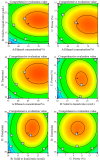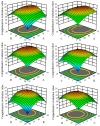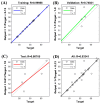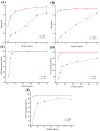Optimization of Flavonoid Extraction from Abelmoschus manihot Flowers Using Ultrasonic Techniques: Predictive Modeling through Response Surface Methodology and Deep Neural Network and Biological Activity Assessment
- PMID: 38893486
- PMCID: PMC11173679
- DOI: 10.3390/molecules29112610
Optimization of Flavonoid Extraction from Abelmoschus manihot Flowers Using Ultrasonic Techniques: Predictive Modeling through Response Surface Methodology and Deep Neural Network and Biological Activity Assessment
Abstract
Understanding the optimal extraction methods for flavonoids from Abelmoschus manihot flowers (AMF) is crucial for unlocking their potential benefits. This study aimed to optimize the efficiency of flavonoid extraction from AMF. After comparing extraction methods, the ultrasonic cell crusher demonstrated superior performance over conventional techniques. Four key factors-solid-to-liquid ratio (1:10 to 1:50 g·mL-1), ethanol concentration (55% to 95%), ultrasonic time (10 to 50 min), and ultrasonic power (5% to 25% of 900 W)-were investigated and normalized using the entropy weight method. This led to a comprehensive evaluation (CE). Optimization of extraction conditions for the ultrasonic cell crusher was achieved through response surface methodology and a deep neural network model, resulting in optimal parameters: ethanol volume fraction of 66%, solid-to-liquid ratio of 1:21 g/mL, extraction efficiency of 9%, and extraction duration of 35 min, yielding a CE value of 23.14 (RSD < 1%). Additionally, the inhibitory effects of the optimized extracts against Streptococcus mutans (S. mutans) were assessed. The results revealed that AMF extract (AMFE) exhibits inhibitory effects on S. mutans, with concomitant inhibition of sucrase and lactate dehydrogenase (LDH). The MIC of AMFE against planktonic S. mutans is 3 mg/mL, with an MBC of 6 mg/mL. Within the concentration range of 1/8 MIC to 2 MIC of AMFE, the activities of sucrase and LDH decreased by 318.934 U/mg prot and 61.844 U/mg prot, respectively. The antioxidant activity of AMFE was assessed using the potassium ferricyanide reduction and phosphomolybdenum methods. Additionally, the effect of AMFE on DPPH, ABTS, and ·OH free radical scavenging abilities was determined. The concentrations at which AMFE exhibited over 90% scavenging rate for ABTS and DPPH free radicals were found to be 0.125 mg/mL and 2 mg/mL, respectively.
Keywords: Abelmoschus manihot flower; Streptococcus mutans (S. mutans); antioxidant activity; dental caries; green extraction; ultrasonic cell crusher.
Conflict of interest statement
The authors declare no conflicts of interest.
Figures











Similar articles
-
Extraction of Flavonoids from the Flowers of Abelmoschus manihot (L.) Medic by Modified Supercritical CO₂ Extraction and Determination of Antioxidant and Anti-Adipogenic Activity.Molecules. 2016 Jun 25;21(7):810. doi: 10.3390/molecules21070810. Molecules. 2016. PMID: 27347916 Free PMC article.
-
Simultaneous process optimization of ultrasound-assisted extraction of polyphenols and ellagic acid from pomegranate (Punica granatum L.) flowers and its biological activities.Ultrason Sonochem. 2021 Dec;80:105833. doi: 10.1016/j.ultsonch.2021.105833. Epub 2021 Nov 15. Ultrason Sonochem. 2021. PMID: 34798525 Free PMC article.
-
Optimization of Ultrasonic-Assisted Extraction of Flavonoid Compounds and Antioxidants from Alfalfa Using Response Surface Method.Molecules. 2015 Aug 26;20(9):15550-71. doi: 10.3390/molecules200915550. Molecules. 2015. PMID: 26343617 Free PMC article.
-
Ultrasonic extraction and antioxidant evaluation of oat saponins.Ultrason Sonochem. 2024 Oct;109:106989. doi: 10.1016/j.ultsonch.2024.106989. Epub 2024 Jul 18. Ultrason Sonochem. 2024. PMID: 39059252 Free PMC article. Review.
-
Chemical constituents, clinical efficacy and molecular mechanisms of the ethanol extract of Abelmoschus manihot flowers in treatment of kidney diseases.Phytother Res. 2021 Jan;35(1):198-206. doi: 10.1002/ptr.6818. Epub 2020 Jul 27. Phytother Res. 2021. PMID: 32716080 Free PMC article. Review.
Cited by
-
Optimization of Ultrasonic-Enzymatic-Assisted Extraction of Flavonoids from Sea Buckthorn (Hippophae rhamnoides L.) Pomace: Chemical Composition and Biological Activities.Foods. 2025 May 8;14(10):1656. doi: 10.3390/foods14101656. Foods. 2025. PMID: 40428435 Free PMC article.
-
Process Optimization and Aroma Composition Study of Wine from Buddha's Hand, Citron, Galangal.Foods. 2025 May 29;14(11):1936. doi: 10.3390/foods14111936. Foods. 2025. PMID: 40509463 Free PMC article.
References
-
- Li Y., Ge Z.H., Duan Q.H., Yu S.L., Li Y.J., Tan X.Y., Wang D. Content Determination of Active Constituents in Abelmoschi Corolla. Asia-Pac. Tradit. Med. 2014;10:16–18.
-
- Ge J., Miao J.J., Sun X.Y., Yu J.Y. Huangkui capsule, an extract from Abelmoschus manihot (L.) medic, improves diabetic nephropathy via activating peroxisome proliferator–activated receptor (PPAR)-α/γ and attenuating endoplasmic reticulum stress in rats. J. Ethnopharmacol. 2016;189:238–249. doi: 10.1016/j.jep.2016.05.033. - DOI - PubMed
-
- Jain P.S., Bari S.B. Anti-inflammatory Activity of Abelmoschus manihot Extracts. Int. J. Pharmacol. 2010;6:505–509. doi: 10.3923/ijp.2010.505.509. - DOI
MeSH terms
Substances
Grants and funding
LinkOut - more resources
Full Text Sources
Medical

